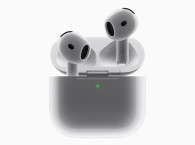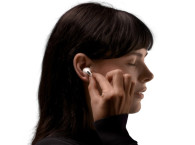When I originally wrote about Apple launching the new AirPods 4 with Active Noise Cancellation, I called the design "industry-defining" and "a big deal for the industry which has been struggling to combine the benefits of the loose-fit form-factor (now also called open-ears) with the convenience of active noise cancellation when required."

I pre-ordered the new AirPods 4 ANC and received a pair last Friday, September 20, as scheduled by Apple. I thought I should share what I learned. Because they are really a very big deal that all product developers in the hearables space need to consider from now on.
While most people in the audio industry have focused on Apple promising a Hearing Test, Hearing Aid features, and Hearing Protection features (coming fall 2024) for the existing AirPods Pro 2 true wireless ANC earbuds, I truly believe that bringing ANC and Adaptive Audio to an "open ear" or "loose-fit" design is a much bigger deal for the market overall.
As I also commented in my post about the AirPods Pro 2 hearing aid announcement, many in the industry reacted to this announcement as though Apple needed to do this to expand sales or something. And this is an important thing to underline: We do not know which of the AirPods models Apple is selling more. Considering that even the most conservative estimates award Apple AirPods with at least 15% market share of the global true wireless stereo (TWS) market, this is a significant business that surpasses by far the overall revenue of many audio companies in this segment.
And it should be clear to all, that the volumes of AirPods Pro 2 earbuds sold to consumers far outpace any volumes that might result from potential buyers looking for the new hearing aid features. It all adds up in the end, but Apple knows that it’s more about increasing the value and benefits of its products to more people. And that many users who have no interest today in hearing aids will discover the potential benefits of the product as is and will grow with it in the future. Because essentially, these are the very first hearables.
You will find this last paragraph in my original article. I repeat it here, because it underlines the importance of "Apple's other announcement" with the AirPods 4 ANC.

A Refined Contour
The Apple AirPods Pro 2 earbuds are in-ears. Meaning, they sit in the opening to the ear canal, benefiting from the passive isolation caused by closing the tympanic cavity. In contrast, the AirPods 4 ANC are an open design or - as I always adopted from an earlier designation - a "loose-fit" design that simply sits in the concha, close to the opening of the ear canal but no causing any occlusion.
This is important to know because, until now, no one had successfully implemented Active Noise Cancellation, a Transparency mode, or much less Adaptive Audio in this form factor. Yes, there are multiple recent attempts to combine "open ear" designs (Huawei and others) with some level of noise reduction and processing. But the ergonomics of the AirPods are completely different, and that's why I like to call them "loose-fit" and not "open ears" in order to distinguish from all the other more recent designs, such as the Bose Ultra Open Earbuds.
Apple prefers to call this successful design simply "a refined contour" but in every presentation they have bragged about the extensive research they conduct to reach that very specific shape. And here is an important finding. The shape of the AirPods 4 ANC is much different from the third-generation AirPods (2021), and even more different from the 2018 AirPods or the earlier EarPods. I have taken a few photos of the three models to compare.

Subjective Impressions
I don't want to write a review of the AirPods 4 ANC, first because I didn't have the required time, and second because I have no intention of doing buyer recommendations. Others are already doing that. I'm writing for audio industry professionals and particularly product managers and product developers and designers in this segment. For those, the AirPods 4 ANC are a really big deal.
Sharing subjective impressions is valid. Because I am sharing what a real user feels, not what it measures. I know that taking measurements of AirPods is a pain, because of the adaptive algorithms and the sophistication of the whole system with sensors, fit adjustments and personalizations (a lot is being written about this - read here and here). Subjective impressions deal with all the possible options and the variability of the personal experience - which will differ from user to user.
That is why tools and methods that assess an overall mean opinion score (MOS) in actual usage evaluation allow for better comparability of human perception.
I've tried to test my own judgments by asking people around me to do the same and share their experiences. But it becomes hard to "translate" their own impressions, because most of the time people don't know what the hell I'm talking about (Apple knows this well and that's why they are so careful with terminology in their consumer-facing communications).


I judge AirPods by playing a sweep at different threshold levels according to the active systems in use, playing directly on the earbuds or playing on my studio monitors, with me listening with the AirPods on with ANC off and using transparency. That's how I judge and compared the systems, and it works. I cannot ask others around me to do that, but a proper lab could easily set up this type of test.
I also compared the AirPods 4 ANC with my AirPods Pro 2 in terms of active noise cancellation performance, playing different types of noise on the monitors around me. But the experience of removing one set of earbuds and putting on others that are so different and require careful adjustments, don't allow for reliable impressions. Overall, I can say that the ANC on the AirPods 4 ANC is surprisingly good. Apple says that the AirPods Pro 2 offer twice the noise cancellation, and that is noticeable with low frequency noise. But otherwise, my impression is that the most noticeable difference results immediately from the occlusion and passive isolation awarded by carefully inserting the AirPods Pro 2 in-ear.
Simply adjusting the listening levels on both systems is a painful experience - and like comparing measurements made with different dummy heads, it's difficult to compare results.
Yes, I am saying that to correctly judge Adaptive ANC true wireless earbuds, with highly personalized options and sophisticated processing systems that react unpredictably can only be done reliably by us personally and subjectively. Yes, I am aware that is a huge problem for anyone trying to consistently evaluate a series of different systems and establish comparisons, such as for tech reviewers and labs that want to generate user-oriented reports (buying guides).
No, it's not a problem for developers, because you focus on the evaluation of your own design and how to optimize the results but knowing you will leave ample margin for the system to adjust to users’ ergonomic attributes, preferences, and listening abilities.


What Was Good About It?
So, what are the results of my experiments and subjective impressions?
Listening on the AirPods 4 ANC sounds totally different from AirPods Pro 2. Not better, but different, and not necessarily bad if you don't like heavy bass. If I had to judge purely in terms of fidelity, I would go for the AirPods Pro 2 obviously. But otherwise, I was not expecting an open design to sound this good and so close.
Switching from listening to my monitors in the room with the AirPods 4 ANC in transparency mode, and removing them sounds very, very close. It's like there's nothing in my ears.
Thanks to the H2 chip, both for the AirPods 4 ANC and the AirPods Pro 2, the controls are the same: Off, Transparency, Adaptive and Noise Cancellation.
As I already mentioned, ANC is remarkably good on both. The response is similar. There's a minimal difference in the lower frequencies. And so is transparency which, as the name says, is "transparent" or extremely efficient. It lacks a bit of "air" when you transition from the real world to AirPods and back. But the sound playing from my monitors was remarkably similar.
More important is the physical experience. While the AirPods Pro 2 make their presence felt in the ears, the AirPods 4 barely cause any pressure. Of course, that experience will change from person to person and the shapes of the inner ear. And AirPods Pro can become much more comfortable when we use smaller ear tips (at the expense of less effectiveness and more inconsistent fit). But I estimate that less than 10% of users would even spend the time to test different fit options and go through all the earbuds tips and setup options and accommodations (a problem audiologists know too well). That is why in general I believe the "loose-fit" earbuds are a better mainstream option.
The AirPods 4 ANC are a really big deal. aX
This article was originally published in The Audio Voice newsletter, (#486), September 26, 2024.







